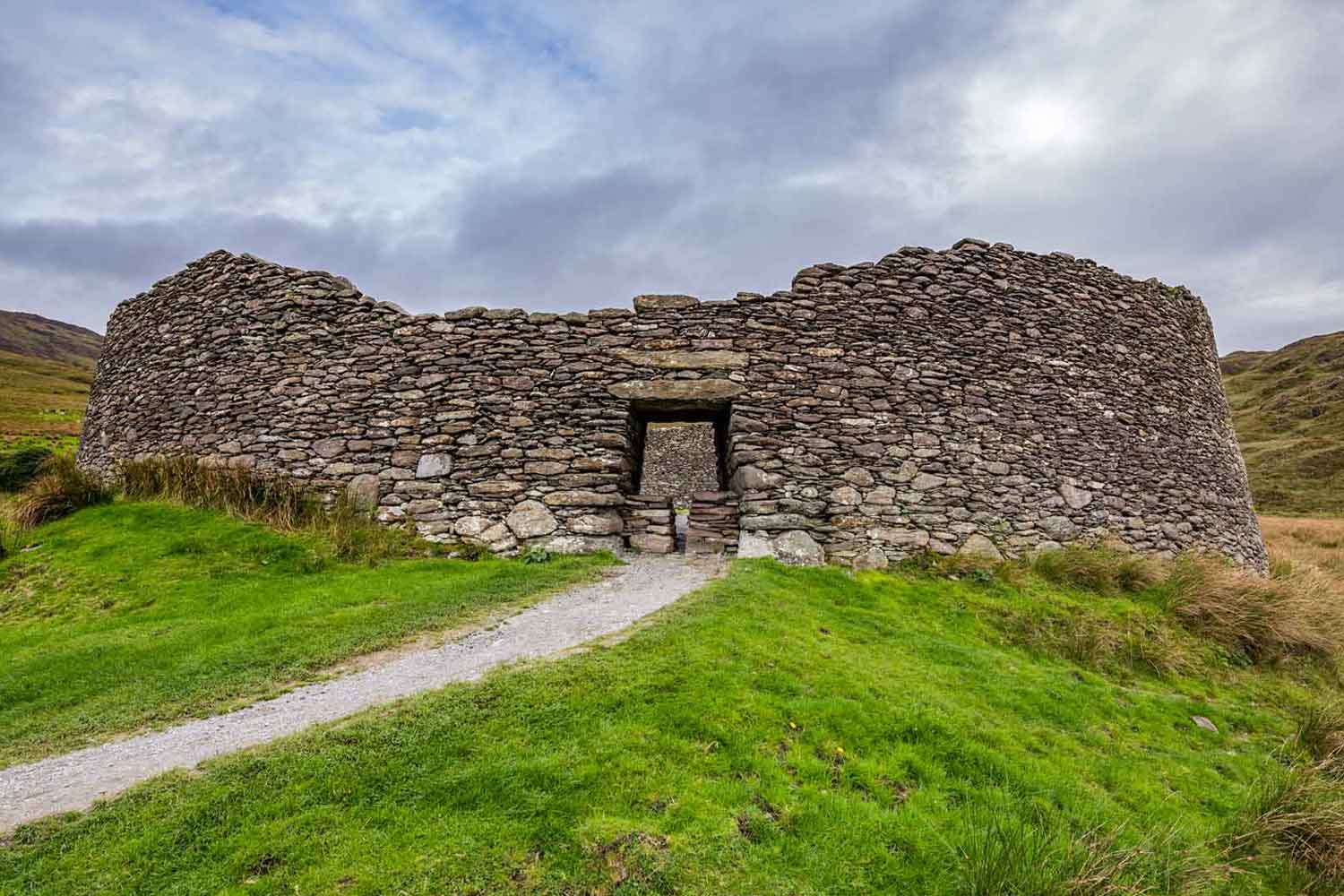Staigue Fort

Location: Staigue, Co. Kerry
Classification: Ringfort - Cashel
SMR Code: KE099-013001-
Rating:
Staigue Fort, although partially ruined, is one of the largest and finest dry-stone, walled ringforts in Ireland. Located on the Iveragh peninsula in County Kerry at the head of a valley opening south to the sea, the fort is surrounded by earthen bank and ditch and is about 27 m (90 ft) in diameter. The walls are up to 6 m (20 ft) high and up to 4 m (13 ft) thick at the base. The interior is accessed through a south-facing, 1.8m passage, roofed with double lintels. Inside is an elaborate network of stairways leading to terraces with two small chambers inside the wall reached by passages. Staigue represents a considerable feat in engineering and building. It was built without mortar, using undressed stones.
Probably built in the early centuries AD as a defensive stronghold for a local chieftain. None of the inner buildings survives to this day, but there was probably a few buildings inside originally. (chieftain's house and some huts for guards and servants). In 1897 T.J. Westropp reported that the local peasantry called the building Staig an air, which he translated as "Windy House", or "Temple of the Father", or "The Staired Place of Slaughter".
As the majority of ringforts were abandoned during the early centuries of the 2nd millennium AD, these constructions began to disintegrate, leaving their remains dotted across the landscape. Over time these decaying circles came to be associated with the fairies, hence the name ‘fairy forts’ and were very much left alone for fear of offending the supernatural beings thought to reside within them. One tale regarding the Staigue ringfort, has it that its fairy inhabitants would compete against the fairies of Cahergal (another ringfort on the Ivereagh Peninsula) in hurling matches; often drafting human players to help them win. Similar folklore regarding local ring forts can be found all around the country.
Description
Staigue Fort, although partially ruined, is one of the largest and finest dry-stone, walled ringforts in Ireland. Located on the Iveragh peninsula in County Kerry at the head of a valley opening south to the sea, the fort is surrounded by earthen bank and ditch and is about 27 m (90 ft) in diameter. The walls are up to 6 m (20 ft) high and up to 4 m (13 ft) thick at the base. The interior is accessed through a south-facing, 1.8m passage, roofed with double lintels. Inside is an elaborate network of stairways leading to terraces with two small chambers inside the wall reached by passages. Staigue represents a considerable feat in engineering and building. It was built without mortar, using undressed stones.
History
Probably built in the early centuries AD as a defensive stronghold for a local chieftain. None of the inner buildings survives to this day, but there was probably a few buildings inside originally. (chieftain's house and some huts for guards and servants). In 1897 T.J. Westropp reported that the local peasantry called the building Staig an air, which he translated as "Windy House", or "Temple of the Father", or "The Staired Place of Slaughter".
Folklore
As the majority of ringforts were abandoned during the early centuries of the 2nd millennium AD, these constructions began to disintegrate, leaving their remains dotted across the landscape. Over time these decaying circles came to be associated with the fairies, hence the name ‘fairy forts’ and were very much left alone for fear of offending the supernatural beings thought to reside within them. One tale regarding the Staigue ringfort, has it that its fairy inhabitants would compete against the fairies of Cahergal (another ringfort on the Ivereagh Peninsula) in hurling matches; often drafting human players to help them win. Similar folklore regarding local ring forts can be found all around the country.
Accessibility Rating: Easy
Carpark - Coffee Shop
Accessibility
Accessibility Class: Easy
Facilities
Carpark - Coffee Shop
Map
Users should note that the Monumental Ireland application and website are information guides only and do not act as an invitation to enter any of the properties or sites listed. No responsibility is accepted by the creators of the Monumental Ireland application for any loss, injury or inconveniences sustained as a result of using it.






